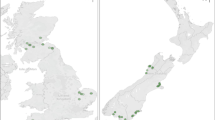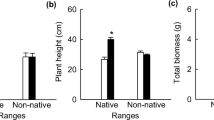Abstract
Common ragweed (Ambrosia artemisiifolia) is an abundant weed in its native North America, despite supporting a wide range of natural enemies. Here, we tested whether these enemies have significant impacts on the performance of this plant in its native range. We excluded enemies from the three principal life-history stages (seed, seedling, and adult) of this annual in a series of field experiments; at the adult stage, we also manipulated soil disturbance and conspecific density. We then measured the consequences of these treatments for growth, survival, and reproduction. Excluding fungi and vertebrate granivores from seeds on the soil surface did not increase germination relative to control plots. Seedling survivorship was only slightly increased by the exclusion of molluscs and other herbivores. Insecticide reduced damage to leaves of adult plants, but did not improve growth or reproduction. Growth and survivorship of adults were strongly increased by disturbance, while higher conspecific density reduced performance in disturbed plots. These results indicate ragweed is insensitive to attack by many of its natural enemies, helping to explain its native-range success. In addition, they suggest that even though ragweed lost most of its insect folivores while invading Europe, escape from these enemies is unlikely to have provided a significant demographic advantage; instead, disturbance is likely to have been a much more important factor in its invasion. Escape from enemies should not be assumed to explain the success of exotic species unless improved performance also can be demonstrated; native-range studies can help achieve this goal.




Similar content being viewed by others
References
Allard HA (1943) The North American ragweeds and their occurrence in other parts of the world. Science 98:292–294
Baskin JM, Baskin CC (1980) Ecophysiology of secondary dormancy in seeds of Ambrosia artemisiifolia. Ecology 61:475–480
Bassett IJ, Crompton CW (1975) The biology of Canadian weeds. 11. Ambrosia artemisiifolia L. and Ambrosia psilostachya DC. Can J Plant Sci 2:463–476
Bassett IJ, Terasmae J (1962) Ragweeds, Ambrosia species, in Canada and their history in postglacial time. Can J Bot 40:141–150
Bazzaz FA (1968) Succession on abandoned fields in the Shawnee Hills, southern Illinois. Ecology 49:924–936
Bazzaz FA (1974) Ecophysiology of Ambrosia artemisiifolia: a successional dominant. Ecology 55:112–119
Bazzaz FA, Mezga DM (1973) Primary productivity and microenvironment in an Ambrosia dominated old-field. Am Midl Nat 90:70–78
Blaney CS, Kotanen PM (2001) Post-dispersal losses to seed predators: an experimental comparison of native and exotic old field plants. Can J Bot 79:284–292
Blossey B, Nötzold R (1995) Evolution of increased competitive ability in invasive nonindigenous plants: a hypothesis. J Ecol 83:887–889
Bolker BM (2008) Ecological models and data in R. Princeton University Press, Princeton
Chauvel B, Dessaint F, Cardinal-Legrand C, Bretagnolle F (2006) The historical spread of Ambrosia artemisiifolia L. in France from herbarium records. J Biogeog 33:665–673
Colautti RI, Ricciardi A, Grigorovich IA, MacIsaac HJ (2004) Is invasion success explained by the enemy release hypothesis? Ecol Lett 7:721–733
Crawley MJ (2007) The R book. Wiley, Chichester
Ehrlen J (2003) Fitness components versus total demographic effects: evaluating herbivore impacts on a perennial herb. Am Nat 162:796–810
Elton CS (1958) The ecology of invasions by animals and plants. Methuen, London
Foster MM, Vitousek PM, Randolph PA (1980) The effects of ragweed (Ambrosia artemisiifolia L.) on nutrient cycling in a 1st-year old-field. Am Midl Nat 103:106–113
Fumanal B, Girod C, Fried G, Bretagnolle F, Chauvel B (2008) Can the large ecological amplitude of Ambrosia artemisiifolia explain its invasive success in France? Weed Res 48:349–359
Funk DJ, Futuyma D, Ortí G, Meyer A (1995) A history of host associations and evolutionary diversification for Ophraella (Coleoptera: Chrysomelidae): new evidence from mitochondrial DNA. Evolution 49:1008–1017
Futuyma DJ, McCafferty SS (1990) Phylogeny and the evolution of host plant associations in the leaf beetle genus Ophraella (Coleoptera: Chrysomelidae). Evolution 44:1885–1913
Genton BJ, Kotanen PM, Cheptou P-O, Adolphe C, Shykoff JA (2005a) Enemy release but no evolutionary loss of defence during ragweed invasion of France: an inter-continental reciprocal transplant experiment. Oecologia 146:404–414
Genton BJ, Shykoff JA, Giraud T (2005b) High genetic diversity in French invasive populations of common ragweed, Ambrosia artemisiifolia, as a result of multiple sources of introduction. Mol Ecol 14:4275–4285
Guo Q (2006) Intercontinental biotic invasions: what can we learn from native populations and habitats? Biol Inv 8:1451–1459
Halpern SL, Underwood N (2006) Approaches for testing herbivore effects on plant population dynamics. J Appl Ecol 43:922–929
Harrison SK, Regnier EE (2003) Postdispersal predation of giant ragweed (Ambrosia trifida) seed in no-tillage corn. Weed Sci 51:955–964
Hierro LJ, Maron JL, Callaway RM (2005) A biogeographical approach to plant invasions: the importance of studying exotics in their introduced and native range. J Ecol 93:5–15
Hill BHC, Silvertown J (1997) Higher-order interaction between molluscs and sheep affecting seedling numbers in grassland. Acta Oecol 18:587–596
Igrc J, Deloach CJ, Zlof V (1995) Release and establishment of Zygogramma suturalis F (Coleoptera, Chrysomelidae) in Croatia for control of common ragweed (Ambrosia artemisiifolia L). Biol Control 5:203–208
Irwin DL, Aarssen LW (1996) Testing for cost of apical dominance in vegetation: a field study of three species. Ann Bot Fenn 33:123–128
Keane RM, Crawley MJ (2002) Exotic plant invasions and the enemy release hypothesis. Trends Ecol Evol 17:164–170
Kirk RE (1995) Experimental design: procedures for the behavioural sciences, 3rd edn. Brooks/Cole, Pacific Grove
Kiss L (2007) Why is biological control of common ragweed, the most allergenic weed in Eastern Europe, still only a hope? In: Vincent C, Goettel MS, Lazarovits G (eds) Biological control: a global perspective. CABI, Wallingford, pp 80–91
Kosola KR, Gross KL (1999) Resource competition and suppression of plants colonizing early successional old fields. Oecologia 118:69–75
Liu H, Stiling P (2006) Testing the enemy release hypothesis: a review and meta-analysis. Biol Inv 8:1535–1545
MacKay J, Kotanen PM (2008) Local escape of an invasive plant, common ragweed (Ambrosia artemisiifolia L.), from above-ground and below-ground enemies in its native area. J Ecol 96:1152–1161
Manson RH, Stiles EW (1998) Links between microhabitat preferences and seed predation by small mammals in old fields. Oikos 82:37–50
Maron JL, Crone E (2006) Herbivory: effects on plant abundance, distribution and population growth. Proc R Soc Lond B 273:2575–2584
Maron JL, Vilà M (2001) When do herbivores affect plant invasion? Evidence for the natural enemies and biotic resistance hypotheses. Oikos 95:361–373
McAndrews JH (1988) Human disturbance of North American forests and grasslands: the fossil pollen record. In: Huntley B, Webb T III (eds) Vegetation history. Kluwer, Dordrecht, pp 673–697
Mitchell CE, Agrawal AA, Bever JD, Gilbert GS, Hufbauer RA, Klironomos JN, Maron JL, Morris WF, Parker IM, Power AG, Seabloom EW, Torchin ME, Vázquez DP (2006) Biotic interactions and plant invasions. Ecol Lett 9:726–740
Paquin V, Aarssen LW (2004) Allometric gender allocation in Ambrosia artemisiifolia (Asteraceae) has adaptive plasticity. Am J Bot 91:430–438
Quinn GP, Keough MJ (2002) Experimental design and data analysis for biologists. Cambridge University Press, Cambridge
R Development Core Team (2008) R: a language and environment for statistical computing. R Foundation for Statistical Computing, Vienna
Raynal DJ, Bazzaz FA (1975) Interference of winter annuals with Ambrosia artemisiifolia in early successional fields. Ecology 56:35–49
Reznik SY, Belokobyl’skiy SA, Lobanov AL (1994) Weed and herbivorous insect population densities at the broad spatial scale: Ambrosia artemisiifolia L. and Zygogramma suturalis F. (Col., Chrysomelidae). J Appl Entomol 118:1–9
Schafer M, Kotanen PM (2003) The influence of soil moisture on losses of buried seeds to fungi. Acta Oecol 24:255–263
Schüder I, Port G, Bennison J (2003) Barriers, repellents and antifeedants for slug and snail control. Crop Prot 22:1033–1038
Sharvelle EG (1961) The nature and uses of modern fungicides. Burgess, Minneapolis
Sokal RR, Rohlf FJ (1994) Biometry: the principles and practices of statistics in biological research, 3rd edn. Freeman, New York
Teshler MP, DiTommaso A, Gagnon JA, Watson AK (2002) Ambrosia artemisiifolia L. common ragweed (Asteraceae). In: Mason PG, Huber JT (eds) Biological control programs in Canada 1981–2000. CABI, Wallingford, pp 290–294
Throop HL (2005) Nitrogen deposition and herbivory affect biomass production and allocation in an annual plant. Oikos 111:91–100
Torchin ME, Mitchell CE (2004) Parasites, pathogens, and invasions by plants and animals. Front Ecol Environ 2:183–190
Torgeson DC (1969) Fungicides: an advanced treatise, vol II. Academic, New York
Yamanaka T, Tanaka K, Otuka A, Bjørnstad ON (2007) Detecting spatial interactions in the ragweed (Ambrosia artemisiifolia L.) and the ragweed beetle (Ophraella communa LeSage) populations. Ecol Res 22:185–196
Ziska LH, George K, Frenz DA (2007) Establishment and persistence of common ragweed (Ambrosia artemisiifolia L.) in disturbed soil as a function of an urban-rural macro-environment. Glob Chang Biol 13:266–274
Acknowledgments
M. Saunders, K.A. Judge, L.J. Robson, M. Lerdau, and two anonymous reviewers for useful comments. A. Simonsen, R. Dinnage, Z. Burivalova, R. MacKenzie, A.M. Petersen, V. Pham and especially K. Kostyukova for helpful field work. J. Stinchcombe and S.C.H. Barrett for advice, Art Weis and KSR for logistical support. This work would have been impossible without the donation of Koffler Scientific Reserve to the University of Toronto by the Koffler family. This work was supported by a Natural Sciences and Engineering Research Council of Canada PGS to A.A.M.M. and a Discovery Grant to P.M.K. These experiments comply with all local laws.
Author information
Authors and Affiliations
Corresponding author
Additional information
Communicated by Manuel Lerdau.
Electronic supplementary material
Below is the link to the electronic supplementary material.
Rights and permissions
About this article
Cite this article
MacDonald, A.A.M., Kotanen, P.M. The effects of disturbance and enemy exclusion on performance of an invasive species, common ragweed, in its native range. Oecologia 162, 977–986 (2010). https://doi.org/10.1007/s00442-009-1557-9
Received:
Accepted:
Published:
Issue Date:
DOI: https://doi.org/10.1007/s00442-009-1557-9




